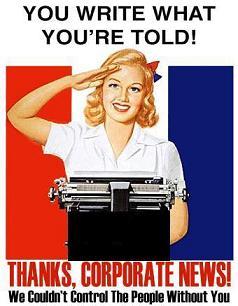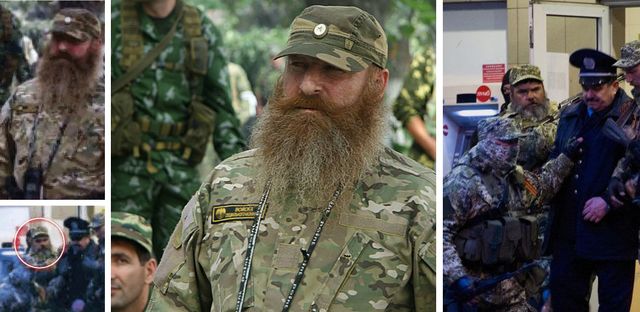

The New York Times responded yesterday to the exposure of its fabricated report alleging that Russian Special Forces are stirring up protests in east Ukraine against the pro-Western regime in Kiev.
An article Tuesday, titled “Scrutiny over Photos Said to Tie Russia Units to Ukraine,” is a clumsy attempt at damage control. Buried in the paper’s inside pages, the article begins: “A collection of photographs that Ukraine says shows the presence of Russian forces in the eastern part of the country, and which the United States has cited as evidence of Russian involvement, has come under scrutiny.” The Times also noted that “US officials” provided some of the pictures to US Secretary of State John Kerry before his talks with Russian, European and Ukrainian officials last Thursday in Geneva.
The Times does not bother to mention that it featured these faked images in a front-page article and photo spread. It was the Times that used its influence to declare “the presence of Russian forces in the eastern part of the country” as part of a propaganda campaign against Russia. Even its own attempt to explain the “scrutiny” the photos came under shows, however, that the Timeswas a party to a grotesque falsification.
One set of photographs, the Times writes, “shows a uniformed man with a long beard who was photographed this year in Slovyansk and Kramatorsk and who, the Ukrainians assert, was also photographed during Russian combat operations in Georgia in 2008, wearing a Special Forces patch… Some observers have asked whether the man photographed in Georgia is the same person photographed in eastern Ukraine.”
If “observers” have questioned the images, it is because higher-resolution versions of the Times’ photos available online show quite clearly that the two are different people. The alleged Russian soldier in Georgia is thinner and has a reddish beard, while the bearded man photographed in eastern Ukraine is stouter and has a greying black beard. (Click here for full resolution)
 The images at the left are the ones presented by the New York Times as evidence that the Russian Special Forces soldier (upper left with red beard) in Georgia in 2008 is the same man in a recent conflict in Kramatorsk. Higher resolution images of the same photos show they are not the same man.
The images at the left are the ones presented by the New York Times as evidence that the Russian Special Forces soldier (upper left with red beard) in Georgia in 2008 is the same man in a recent conflict in Kramatorsk. Higher resolution images of the same photos show they are not the same man.The two men looked similar only because the Times published only low-resolution, black and white versions of the images available online.
The Times also admitted there was a “question” over a “group photograph taken in Russia” that featured prominently in its report. The Times used the photo to claim that the men in the photo were Russian soldiers, and that other pictures of the men, taken in Slovyansk, were proof that the Russian soldiers were infiltrating Ukraine.
In fact, the Times’ claim that the “group photograph” was “taken in Russia” was a lie. “It was taken in Slovyansk,” the photographer who took the picture, freelancer Maxim Dondyuk, told the Times. “Nobody asked my permission to use this photograph.”
The Times article shows that the “newspaper of record” did not engage in the most elementary fact-checking of material it was handed by the Kiev regime and the US State Department, before plastering the alleged “evidence” on its front page.
This raises the question of how the Times’ photo report was published in the first place. Either the Times editors rammed through the piece and its blurry photos without any independent examination, or the editors did check the story, saw it was a grotesque falsification, and published it anyway.
In either case, the Times functioned not as a legitimate journalistic outlet, but as a propaganda agency of the state.
Several additional questions are raised:
· How was the decision to publish the fabricated photo report taken, and by whom?
· What was the Times’ role in the fraud? Did it doctor the photos, or did it uncritically publish photos doctored by as-yet-unnamed operatives in Kiev or in Washington?
· Do Times staff subject information they receive from the state to any critical review?
The Times’ publication of the photos is not an innocent act. It provided political ammunition for US officials to press the puppet regime in Kiev to crack down on protests in Eastern Ukraine. The photo report appeared as US Vice President Joe Biden left for Kiev to ramp up tensions with Russia.
Russian Foreign Minister Sergey Lavrov indicated yesterday that Moscow intends to respond to any crackdown on ethnic Russians in east Ukraine by mounting a real intervention. This poses the direct threat of military conflict between Russia and Ukraine, potentially sparking a global war involving nuclear-armed powers.
The fraudulent photo report and the subsequent attempt at a cover-up is part of a long history of state propaganda masquerading as journalism at theTimes. Most infamously, in the lead-up to the US invasion of Iraq in 2003,Times journalist Judith Miller published articles based on false intelligence provided by the Bush administration that Iraq had weapons of mass destruction (WMD). The Times played a leading role in spreading these lies.
During the Syrian war scare last year, the Times published an article purporting to show that a chemical weapons attack in Ghouta, Syria could only have been launched from government positions, which would cross “red line” and provoke a US war in Syria.
Ultimately, however, the war did not take place, and the Times’ article proved to be based on a lie. As was documented by Seymour Hersh, the attack was launched by allies of the United States, including Turkey and Syrian opposition forces, in a criminal attempt to stoke war. Hersh’s report was systematically ignored by the US media, including the Times .
In addition to publishing lies to railroad the public into interventions in Iraq, Syria and now Russia, the Times also suppresses revelations that might embarrass the ruling elite. In 2004, for example, the Times delayed publication of stories on mass NSA wiretapping until after the 2004 presidential elections, at the request of the Bush administration.
In 2010, then Times editor Bill Keller laid out his paper’s position in his response to the revelations of WikiLeaks. Stressing that he was in constant discussion with American officials over whether to publish different stories, Keller wrote: “We agree wholeheartedly that transparency is not an absolute good. Freedom of the press includes freedom not to publish, and that is a freedom we exercise with some regularity.”
For the Times, freedom of the press is not a matter of the public’s right to know what the state is doing, but the right of the state to suppress information or, as the case of Ukraine shows, to deliberately poison public opinion with outright fabrications.
By Alex Lantier, WSWS
http://www.wsws.org/en/articles/2014/04/24/nytu-a24.html
